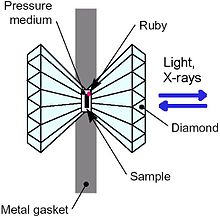- Mineral physics
-
This article is about high-pressure physics of minerals. For physical attributes of minerals like cleavage, see Mineralogy#physical mineralogy.
Mineral physics is the science of materials that compose the interior of planets, particularly the Earth. It overlaps with petrophysics, which focuses on whole-rock properties. It provides information that allows interpretation of surface measurements of seismic waves, gravity anomalies, geomagnetic fields and electromagnetic fields in terms of properties in the deep interior of the Earth. This information can be used to provide insights into plate tectonics, mantle convection, the geodynamo and related phenomena.
Laboratory work in mineral physics require high pressure measurements. The most common tool is a diamond anvil cell, which uses diamonds to put a small sample under pressure that can approach the conditions in the Earth's interior.
Contents
Creating high pressures
The pace of progress in mineral physics has been determined, to a large extent, by the technology for reproducing the high pressures and temperatures in the Earth's interior. The most common tools for achieving this have been:
Shock compression
Many of the pioneering studies in mineral physics involved explosions or projectiles that subjected a sample to a shock. For a brief time interval, the sample is under pressure as the shock wave passes through. Pressures as high as any in the Earth have been achieved by this method. However, the method has some disadvantages. The pressure is very non-uniform and is not adiabatic, so the pressure wave heats the sample up in passing. The conditions of the experiment must be interpreted in terms of a set of pressure-density curves called the Hugoniot curves.[1]
Multi-anvil press
Multi-anvil presses involve an arrangement of anvils to concentrate pressure from a press onto a sample. Unlike shock compression, the pressure exerted is steady, and the sample can be heated using a furnace. Pressures equivalent to depths of 700 km and temperatures of 1500°C can be attained. The apparatus is very bulky and cannot achieve pressures like those in the diamond anvil cell (below), but they can handle much larger samples that can be examined after the experiment.[2]
Diamond anvil cell
The diamond anvil cell is a small table-top device for concentrating pressure. It can compress a small (sub-millimeter sized) piece of material to extreme pressures, which can exceed 3,000,000 atmospheres (300 gigapascals).[3] This is beyond the pressures at the center of the Earth. The concentration of pressure at the tip of the diamonds is possible because of their hardness, while their transparency and high electrical conductivity allow a variety of probes can be used to examine the state of the sample. The sample can be heated to thousands of degrees.
Properties of materials
Equations of state
To deduce the properties of minerals in the deep Earth, it is necessary to know how their density varies with pressure and temperature. Such a relation is called an equation of state (EOS). A simple example of an EOS that is predicted by the Debye model for harmonic lattice vibrations is the Mie-Grünheisen equation of state:
where CV is the heat capacity and γD is the Debye gamma. The latter is one of many Grünheisen parameters that play an important role in high-pressure physics. A more realistic EOS is the Birch–Murnaghan equation of state.[4]
Interpreting seismic velocities
Inversion of seismic data give profiles of seismic velocity as a function of depth. These must still be interpreted in terms of the properties of the minerals. A very useful heuristic was discovered by Francis Birch: plotting data for a large number of rocks, he found a linear relation of the compressional wave velocity vp of rocks and minerals of a constant average atomic weight
 with density ρ:[5][6]
with density ρ:[5][6] .
.
This makes it possible to extrapolate known velocities for minerals at the surface to predict velocities deeper in the Earth.
Other physical properties
- Viscosity
- Creep (deformation)
- Melting
- Electrical conduction and other transport properties
Notes
- ^ Ahrens 1980
- ^ LLNL 2010
- ^ Hemley & Ashcroft 1998
- ^ Poirier 2000
- ^ Birch 1961, JGR
- ^ Birch 1961, GJRAS
References
- Birch, F. (1961). "The velocity of compressional waves in rocks to 10 kilobars. Part 2". Journal of Geophysical Research 66 (7): 2199–2224. Bibcode 1961JGR....66.2199B. doi:10.1029/JZ066i007p02199.
- Ahrens, T. J. (1980). "Dynamic compression of Earth materials". Science 207 (4435): 1035–1041. Bibcode 1980Sci...207.1035A. doi:10.1126/science.207.4435.1035.
- Birch, F. (1961). "Composition of the Earth's mantle". Geophysical Journal of the Royal Astronomical Society 4: 295–311. Bibcode 1961GeoJI...4..295B. doi:10.1111/j.1365-246X.1961.tb06821.x.
- Hemley, Russell J.; Ashcroft, Neil W. (1998). "The Revealing Role of Pressure in the Condensed Matter Sciences". Physics Today 51 (8): 26. Bibcode 1998PhT....51h..26H. doi:10.1063/1.882374.
- Poirier, Jean-Paul (2000). Introduction to the Physics of the Earth's Interior. Cambridge Topics in Mineral Physics & Chemistry. Cambridge University Press. ISBN 0-521-66313-X.
- "Studying the Earth's formation: The multi-anvil press at work". Lawrence Livermore National Laboratory. https://www.llnl.gov/str/Minarik.html. Retrieved 29 September 2010.
External links
Geophysics Overview Subfields Geophysical fluid dynamics · Geodesy · Geodynamics · Geomagnetism · Mathematical geophysics · Mineral physics · Near-surface geophysics · Paleomagnetism · Seismology · TectonophysicsPhysical Phenomena Coriolis effect · Earth's magnetic field · Geodynamo · Geothermal gradient · Gravity of Earth · Mantle convection · Seismic waveOrganizations American Geophysical Union · Canadian Geophysical Union · Environmental and Engineering Geophysical Society · European Geosciences Union · International Union of Geodesy and Geophysics · Royal Astronomical Society · Society of Exploration Geophysicists · Seismological Society of AmericaCategories:
Wikimedia Foundation. 2010.


